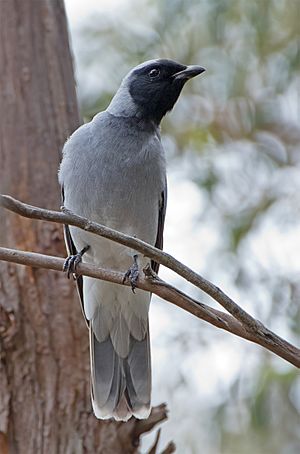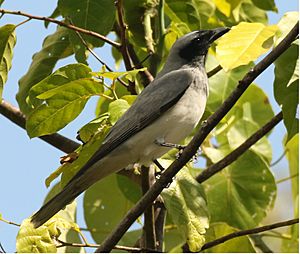Black-faced cuckooshrike facts for kids
Quick facts for kids Black-faced cuckooshrike |
|
|---|---|
 |
|
| Conservation status | |
| Scientific classification | |
| Genus: |
Coracina
|
| Species: |
novaehollandiae
|
| SynonymsAustralian Faunal Directory: Coracina (Coracina) novaehollandiae novaehollandiae | |
|
|
The black-faced cuckooshrike (Coracina novaehollandiae) is a common bird found in Australia and southern New Guinea. It's a type of passerine bird, which means it's a perching bird. These birds eat both plants and animals. In Australia, they are protected by law.
You can find black-faced cuckooshrikes in most wooded areas. They don't usually live in rainforests. However, they are also common in cities like Sydney and Perth. You might often see them sitting on power lines.
Contents
About the Black-faced Cuckooshrike
The black-faced cuckooshrike was first described by a German scientist named Johann Friedrich Gmelin in 1789. The Yindjibarndi people, who live in parts of Australia, call this bird julgira. They used to keep these birds as pets by clipping their wings.
What They Look Like
Adult black-faced cuckooshrikes have a very noticeable black face and throat. Their body feathers are gray, and their belly is white. They have a bill that is a bit hooked. These birds are usually between 32 and 34 centimeters long. They move slowly and quietly. Their call is a loud, screaming sound that sounds like "creearck."
What They Eat
Black-faced cuckooshrikes eat many different things. Their diet mainly includes insects, their larvae (young forms), and caterpillars. They also eat other small invertebrates (animals without backbones). They can catch insects while flying or find them by looking through leaves. They also enjoy eating some fruits and seeds.
How They Behave
The breeding season for these birds is mostly from August to February each year. Both the male and female birds work together to build a small nest. After the eggs hatch, the young birds, called fledglings, leave the nest in about three weeks. Young birds look similar to adults, but their black face mask is smaller, like an eye stripe.
When it's not breeding season, black-faced cuckooshrikes often gather in large groups. These groups can have up to a hundred birds. Some of these birds might migrate (move to different places) during certain times of the year. Others might stay in the same area all year round. Scientists find it hard to track where these birds go in winter because different groups in Australia look very similar.
References
- Gould, J. 1838. A Synopsis of the Birds of Australia, and the Adjacent Islands. London : J. Gould 8 pp., 73 pls.
- Mathews, G.M. 1911. Untitled. Bulletin of the British Ornithologists' Club 27(171): 99–101
- Schodde, R. & Mason, I.J. 1999. The Directory of Australian Birds : Passerines. A Taxonomic and Zoogeographic Atlas of the Biodiversity of Birds in Australia and its Territories. Collingwood, Australia : CSIRO Publishing x 851 pp. (Black-faced Cuckoo-shrike)
See also
 In Spanish: Oruguero carinegro para niños
In Spanish: Oruguero carinegro para niños



